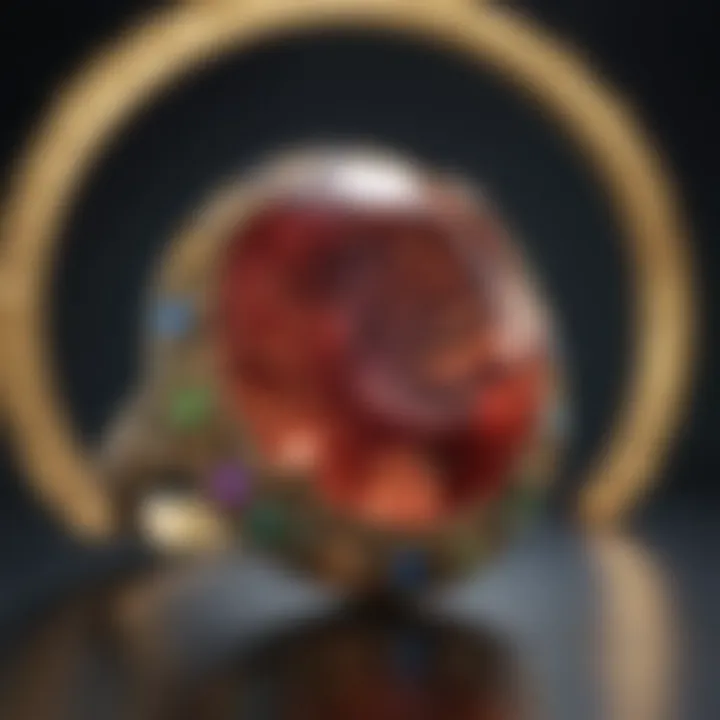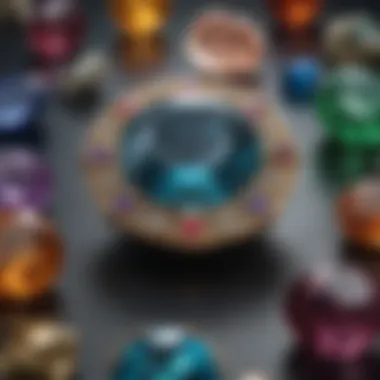Understanding Birthstones: Their Significance Explained


Intro
The exploration of birthstones unveils an intriguing blend of history, culture, and personal connection. Each gemstone, tied to a month, possesses distinct meanings and characteristics that often resonate with individual experiences and values.
As we embark on this journey, it is essential to grasp the foundational elements that define gemstones and their classifications to appreciate their significance fully. This understanding allows gemstone enthusiasts, collectors, and those seeking personal meaning to navigate the rich tapestry of birthstones with informed awareness.
Gemstone Overview
Definition and Characteristics
A gemstone is a piece of mineral that, when cut and polished, is used in adornments or jewelry. Some gemstones are organic materials, such as pearls or amber. These stones stand out not only for their beauty but also for their historical and metaphysical relevance. Gemstones often feature unique colors, patterns, and translucency, which enhance their aesthetic appeal and value in the market.
Classification of Gemstones
Gemstones can be classified based on their composition and properties. The two main categories are:
- Precious Gemstones: These are rare and highly sought after. Examples include diamonds, rubies, sapphires, and emeralds. Their rarity often correlates with their cost, as these stones have significant cultural and economic value.
- Semi-Precious Gemstones: This category encompasses a broader range of stones that are more abundant and generally less expensive. Examples include amethyst, garnet, and aquamarine. While they may not carry the same level of prestige as precious stones, they possess beauty and uniqueness that attract collectors and jewelry makers.
Understanding the distinctions between these classifications is crucial for collectors and enthusiasts alike, as it can influence their choices in purchasing and valuing gemstones.
Properties of Gemstones
Physical Properties
The physical attributes of gemstones include aspects such as hardness, luster, and specific gravity. Hardness is measured on the Mohs scale, which ranks minerals based on their resistance to scratching. For instance, diamond, the hardest gemstone, scores a perfect ten, while talc, the softest, scores a one.
- Luster: This describes how light interacts with the surface of the stone. Gemstones may exhibit different types of luster including vitreous (glass-like) or pearly.
- Specific gravity: This refers to the density of a gemstone compared to the density of water, impacting how the stone feels in hand and its overall market value.
Chemical Properties
The chemical makeup of gemstones contributes significantly to their appearance and durability. Each gemstone is comprised of specific elements, whether that is carbon in diamonds or aluminum and oxygen in sapphires. These elemental compositions affect properties like color and transparency, making chemical properties vital for identification and valuation.
"Understanding the chemical structure of gemstones deepens one’s appreciation of their beauty and rarity, ultimately guiding more informed purchasing decisions."
This exploration into the essence of gemstones sets the groundwork for a deeper understanding of birthstones and their varied significance across cultures. As we continue our exploration, we will delve into the historical origins and cultural meanings tied to birthstones, shedding light on their contemporary relevance.
The Concept of Birthstones
Birthstones have captivated human interest across cultures and eras, offering more than mere aesthetic appeal. They hold significance deeply rooted in history, culture, and personal identity. This section aims to delve into the essence of birthstones, setting the stage for a nuanced understanding of their implications and relevance in contemporary society.
Definition of Birthstones
Birthstones are gemstones associated with specific months of the year. Each stone is believed to embody unique traits and properties tied to the time of one’s birth. Traditionally, wearing one's birthstone is thought to confer beneficial qualities, including health, prosperity, and emotional stability. The practice of linking gemstones to specific months originated from ancient traditions, where various stones were chosen based on their perceived metaphysical properties.
Cultural Origins
The origins of birthstones trace back to antiquity. Historical texts suggest that gemstones were linked to the twelve tribes of Israel, each tribe representing a different stone. These stones were eventually associated with the twelve months in the Roman calendar, forming the foundation of modern practices. Cultures ranging from Hindu to Western have embraced these traditions, each infusing unique interpretations and importance into the stones associated with their respective birth months. Understanding the historical context enhances appreciation for the stones’ cultural resonance, bridging ancient beliefs with modern sentiment.
Evolution Over Time
Over the centuries, the conception and significance of birthstones have evolved. Initially, gemstones were primarily seen as talismans or symbols of prosperity and protection. As society transformed, so did the perceptions of these stones. Today, birthstones are not only regarded for their historical and cultural meanings but also for individual aesthetics and personal connection. Jewelers have adapted these meanings, creating custom pieces that reflect personal beliefs and experiences. This evolution illustrates how birthstones have transitioned from mere gemstones to integral components of identity and self-expression.
"The significance of birthstones reflects a blend of tradition and personal connection, making them a fascinating topic of exploration."
Ultimately, understanding the concept of birthstones provides a rich framework to appreciate their role in culture and personal identity. By examining their definitions, cultural origins, and evolution, we set the groundwork for a deeper exploration of each month's gemstone, elucidating why they continue to hold significance in today’s world.
Monthly Birthstones Overview
The section on monthly birthstones serves as a foundation for understanding the distinct characteristics and significances attributed to each gemstone associated with a particular month. Each birthstone holds its own historical context, cultural value, and perceived metaphysical properties, making it significant for anyone looking to explore the depths of these natural wonders. This overview not only brings a systematic approach to understanding birthstones but also invites readers to reflect on personal connections and meanings attributed to each stone.
January: Garnet


Historical Significance
The garnet, the birthstone for January, has been revered since ancient times. Its historical use dates back to the Egyptians, who adorned themselves with garnets in burial rituals as symbols to ensure safe passage in the afterlife. The deep red garnet is often associated with bravery and protection, notably used in jewelry by nobles also during the Middle Ages, signifying wealth and social status. This rich backdrop makes garnet a compelling choice for those interested in gemstones with a storied past.
Physical and Metaphysical Properties
In terms of physical beauty, garnets are known for their vibrant red hues, although they can exist in various colors. They are fairly durable, making them suitable for daily wear. Metaphysically, garnet is believed to inspire love and devotion, enhancing relationships. This stone encourages emotional balance and self-confidence, appealing both to jewelry makers and wearers.
February: Amethyst
Historical Significance
Amethyst has a long-standing reputation as a stone of clarity. Historically, it was once reserved for royals and clergy, symbolizing wisdom and sobriety. Its name is derived from the Greek word "amethystos," meaning "not intoxicated." This regal association adds a layer of significance for those seeking gemstones that signify social sophistication and strength of character.
Physical and Metaphysical Properties
The physical appeal of amethyst lies in its striking purple color, which can vary from light lavender to deep violet. Amethyst is known for its ability to calm the mind and promote tranquility, making it a popular choice in modern meditation practices. Its perceived protective qualities further enhance its desirability as a cherished stone.
March: Aquamarine
Historical Significance
Aquamarine has been praised throughout history, particularly by sailors who considered it a lucky stone. They believed it would safeguard them at sea. Its name, derived from the Latin word for seawater, reflects its light blue colors, echoing the ocean's depths. This connection to water makes it a significant choice for individuals who feel drawn to natural elements.
Physical and Metaphysical Properties
Aquamarine is renowned for its clarity and brilliance. It is also recognized for its soothing properties, believed to promote emotional healing and equilibrium. As a calming stone, it is favored by those who seek clarity in communication and peace in relationships, making it relevant for complementary aspects of human interaction.
April: Diamond
Historical Significance
Diamonds have long been symbols of love and commitment, often seen in engagement rings. Their formation over millions of years in extreme conditions adds to their allure and mystique. Historically significant as the hardest natural substance, diamonds were used as a measure of power and prestige in ancient civilizations, which still resonates today.
Physical and Metaphysical Properties
Physically, diamonds are unparalleled in hardness, making them ideal for various types of jewelry. Beyond their physical characteristics, diamonds are believed to promote strength, clarity, and abundance. They symbolize eternal love and commitment, thus gaining a central role in personal adornments and celebrations.
May: Emerald
Historical Significance
Emeralds have captivated many, especially during the reign of Cleopatra, who was known for her affinity for the stone. Their rich green color symbolizes fertility and rebirth. Cultures throughout history have regarded emeralds as symbols of wisdom and patience, making them a respected choice for gemstone enthusiasts.
Physical and Metaphysical Properties
Emeralds' vibrant green embodies beauty and life, yet they are more delicate than other gemstones. They are believed to encourage harmony and promote emotional balance. This duality of beauty combined with a sense of fragility appeals to individuals seeking both elegance and depth in their gemstone choices.
June: Pearl and Alexandrite
Historical Significance
Pearls and alexandrite hold unique historical significance. Pearls have been symbols of purity and elegance for thousands of years, while alexandrite, discovered in the early 19th century, is famed for its remarkable color-changing properties.
Physical and Metaphysical Properties
Both pearls and alexandrite present distinct physical traits. Pearls are smooth and iridescent, symbolizing beauty and sophistication, whereas alexandrite's color shift makes it utterly unique. Metaphysically, pearls are associated with sincerity and wisdom, while alexandrite is linked to transformation, appealing to those interested in growth and change.
July: Ruby
Historical Significance


As a symbol of passion and vitality, rubies have adorned regal crowns and jewelry for centuries. Historically, they were believed to provide protection and bring good health to their wearers. This deep-rooted significance enhances ruby's popularity in personal and ceremonial uses.
Physical and Metaphysical Properties
With their rich red hue, rubies are visually striking and durable, making them ideal for long-lasting jewelry. Metaphysically, rubies signify energy and strength, promoting emotional health and trust in oneself, transforming them into a coveted choice for many.
August: Peridot
Historical Significance
Peridot has an interesting history. It is often associated with light and is believed to bring healing and a sense of calm. Ancient Egyptians cherished this gem, referring to it as the "gem of the sun," due to its vibrant green color.
Physical and Metaphysical Properties
Peridot's unique olive-green shade combines beauty and rarity. It is noted for its ability to promote harmony and positivity. Its lightweight nature makes it a comfortable choice for various designs, appealing to those who appreciate both aesthetics and emotional balance in their jewelry.
September: Sapphire
Historical Significance
Sapphires have been revered since ancient times, often associated with royalty and divine favor. They signify wisdom and nobility. This historical value makes sapphires popular for engagement rings and other important wedding jewelry.
Physical and Metaphysical Properties
The deep blue hues of sapphires are mesmerizing and evoke a sense of calm and depth. Sapphires are durable, making them suitable for everyday jewelry. Their metaphysical properties are believed to enhance intuition and promote a sound mind.
October: Opal and Tourmaline
Historical Significance
Opal and tourmaline are often appreciated for their unique appearance and diverse history. Opals, known for their vibrant play of color, were considered symbols of hope and creativity in various cultures, while tourmaline has long been admired for its vast range of colors and healing properties.
Physical and Metaphysical Properties
Both opals and tourmalines exhibit exquisite colors, making them favored in artistic jewelry designs. Opals offer a unique visual experience, while tourmaline is said to foster compassion and understanding, making both stones sought after for personal and creative purposes.
November: Topaz and Citrine
Historical Significance
Topaz and citrine have historically been valued for their warmth and brilliance. Topaz is often viewed as a stone of wealth and power, while citrine's vibrant yellow color symbolizes optimism and clarity.
Physical and Metaphysical Properties
Both gemstones are durable and visually striking, thus appealing to a range of tastes. They are believed to promote positivity and prosperity. Their cheerful and warm hues fit well into varied styles, making them desirable selections for jewelry.
December: Turquoise and Tanzanite
Historical Significance
Turquoise has been worn since antiquity as a symbol of protection, while tanzanite, discovered relatively recently, is recognized for its striking violet-blue color, enhancing its appeal.
Physical and Metaphysical Properties
Turquoise provides a sense of tranquility with its unique blue-green tones, while tanzanite is admired for its rarity and captivating color shift. Both are associated with healing and communication, representing the evolving nature of gemstone significance.
Choosing the Best Birthstone
Selecting a birthstone is a personal journey that encompasses preferences, beliefs, and cultural connections. Understanding the right stone is essential for those who want to acknowledge their identity through these gemstones. The choice may reflect an individual's personality, astrological sign, or even familial traditions. Each stone carries its unique attributes, and individuals often find profound connections with them. Hence, exploring factors like personal style and cultural implications is valuable.
Personal Preferences


Choosing a birthstone can significantly depend on personal taste and aesthetic preferences. Factors like color and design play a critical role in this selection process.
Color and Aesthetics
Color is often the first aspect that draws attention to a gemstone. A vibrant red garnet, a serene blue aquamarine, or a deep green emerald can evoke different emotions and signify various meanings. The right color can enhance the wearer's appearance and align with their taste.
People tend to choose stones that resonate with their personality. Those who appreciate calmness might lean towards colors like blue and green, whereas those who seek vibrancy might opt for reds and yellows. Additionally, when selecting jewelry, the stone’s color needs to suit the occasion. For daily wear, a subtle shade might be more appropriate, while more bold colors can shine at special events.
Advantages of choosing based on color include personalization of style and confidence boost when wearing something aesthetically appealing. However, a disadvantage can sometimes arise when individuals fixate solely on appearance, potentially overlooking the stone's deeper meanings.
Symbolic Meaning
The symbolic meaning of a birthstone adds a layer of depth to its selection. Each stone has a history, connected to specific virtues and healing properties. For instance, aquamarine symbolizes calm and clarity, which may appeal to a person going through turbulent times. Similarly, ruby stands for love and passion, often attracting romantic individuals.
Understanding the symbolic meanings can enhance the significance of a chosen gemstone. People often prefer stones that mirror their life goals or aspirations.
Choosing based on symbolic meaning can enrich the experience of owning the stone and provide a profound connection. On the other hand, some might feel overwhelmed by various interpretations and struggle to find a stone that aligns perfectly with their intentions.
Astrological Influence
Astrology holds a significant place in the realm of birthstones. Each stone corresponds to specific zodiac signs, which some believe can influence one’s behavior and experiences. For example, certain gemstones are thought to enhance traits associated with specific astrological signs. Those interested in astrology may prioritize these influences when selecting their birthstone. This adds an element of spirituality in the selection process, tying personal beliefs into the decision-making.
Cultural and Familial Considerations
Cultural significance can also guide one’s choice. In many cultures, specific stones hold traditional importance or are associated with lengthened family legacies. These gemstones may be passed down through generations as heirlooms, carrying stories and memories.
Familial considerations can provide context for the selection process. An individual might choose a specific stone to honor a legacy or as a tribute to family traditions. This choice reflects both personal enjoyment and cultural appreciation, intertwining the past with the present.
Taking cultural aspects into account fosters a deeper bond with the chosen gemstone, thus highlighting its relevance beyond mere aesthetics. However, this may also lead individuals to feel pressure to adhere to certain family norms or cultural practices.
In summary, selecting a birthstone is a multifaceted process influenced by personal preferences, astrological insight, and cultural significance. By weighing these factors, individuals can choose a gemstone that resonates with their identity and values.
This understanding of preferences, aesthetics, and meanings serves as a guiding principle for anyone seeking to find their best birthstone.
Impact on Personal Identity
Birthstones hold significant value in the identity of individuals. Their importance is not merely cosmetic; rather, they embody personal traits, cultural values, and astrological influences. The choice of a birthstone can reflect personal philosophy or aesthetic preferences. Wearing a gemstone associated with one's birth month can create a sense of belonging and connection to one's identity.
Psychological Aspects of Birthstones
The psychological aspects of birthstones are profound. Many people attribute various emotional and mental benefits to their gemstones. Several studies suggest that gems can influence mood and well-being. For example, some believe that wearing an amethyst can promote calmness and clarity. This psychological connection fosters a deeper understanding of oneself. Furthermore, the belief in metaphysical properties can enhance an individual's self-image and confidence. This makes gemstones much more than mere accessories.
Role in Jewelry and Personal Adornment
Jewelry plays a crucial role in how individuals express their identity. Birthstones enhance this personal expression by providing a tailored aesthetic that resonates with the wearer. Many individuals choose birthstones not solely for beauty but for the emotional attributes they symbolize.
Trends in Jewelry Design
Trends in jewelry design have evolved, with birthstones increasingly gaining prominence. Designers often highlight these stones in unique ways, focusing on minimalistic styles that allow the gemstone to shine. This trend reflects a desire for authenticity and personal connection to the jewelry. Many customers find such designs appealing due to their simplicity and elegance, leading to a growing market for personalized pieces. However, the eyewear and the soft and vibrant colors of gems can also be overpowering if not designed thoughtfully.
Significance of Custom Pieces
The significance of custom pieces is paramount in today’s jewelry market. More consumers seek unique items that tell their individual stories. Custom jewelry allows for a personal touch, further tying the wearer to their birthstone. This blending of artistic design with personal significance makes custom pieces popular. Yet, while many celebrate this uniqueness, the process can be more time-consuming and often more expensive than opting for ready-made pieces. Despite this, the emotional payoff for many wearers is well worth the investment.
Culmination
In contemplating the best birthstone, it is essential to recognize the multifaceted significance these gemstones hold. This conclusion synthesizes the findings throughout the article and reflects on the broader implications of gemstone selection.
Synthesis of Findings
Through our exploration, we have uncovered various layers of meaning attributed to each month's gemstone. Each birthstone carries unique historical backgrounds, cultural narratives, and personal significance. These gems are not only valued for their visual appeal; they embody rich traditions and personal connections. The understanding of each stone’s properties offers insight into how they can enhance one’s life, emphasizing their psychological, metaphysical, and aesthetic value.
Moreover, the act of selecting a birthstone transcends mere ornamentation. It serves as a form of self-expression and identity. Many individuals find that their chosen birthstone resonates with their astrological profile, solidifying a strong bond between the user and the stone. Understanding these aspects is crucial for both gemstone enthusiasts and jewelery designers, as it brings depth to the crafting and selection process.
Future Considerations in the Study of Birthstones
The understanding of birthstones continues to evolve. As trends shift, so do the perspectives surrounding gem significance. Future studies should delve into how modern cultural shifts and scientific advancements affect the way people engage with their birthstones. It is also vital to consider the ethical implications of gemstone sourcing and the increasing demand for sustainable practices in the jewelry industry.
Further exploration into the metaphysical benefits of birthstones can yield valuable insights. Research could focus on how these gemstones impact mental well-being, attracting both collectors and those interested in the spiritual realm.



